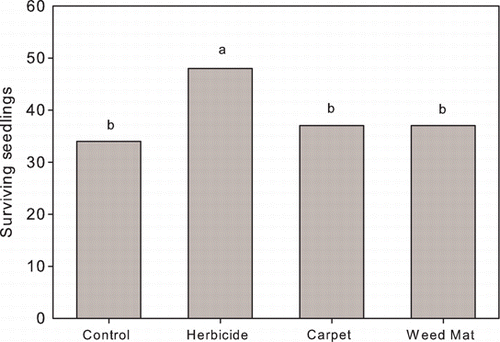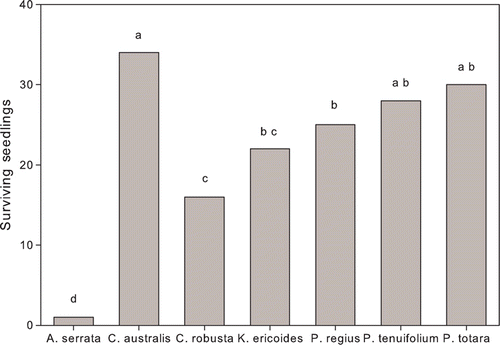Abstract
Riparian zones are important for influencing stream habitat and water quality. Efforts to populate these areas with native species are frequently hindered by fast-growing weed species. A trial was installed to examine riparian establishment alongside the Sherry River in the Motueka river catchment with seven native species and four weed-control treatments. After 2 years, herbicide use significantly improved seedling survival compared with the other weed-control treatments, but weed mats promoted greater seedling height and crown diameter growth. Seedling survival and growth varied significantly with species. After comparisons of costs and practical issues, weed mats were concluded to provide the most suitable weed control. Cordyline australis had the highest survival rate, developed the most crown area and performed well in terms of height increment; Pittosporum tenuifolium and Plagianthus regius also performed well. All three native species are recommended for use in further plantings at this and other similar locations.
Introduction
In terms of managing catchments to meet a range of environmental needs, the riparian zone is probably the most important site for enhancing stream habitat and water quality (Phillips & Marden Citation2003). The different functions of riparian margins include bank stabilisation, filtration of run-off, removal of nutrients from shallow groundwater, shading to reduce water temperature and waterway weeds and the provision of habitat for vertebrates and invertebrates both in-stream and on land. Because of their location and the functions they provide, riparian zones are places where management interventions can have a disproportionate effect relative to the rest of the catchment in controlling the effects of broader catchment activities on streams and downstream aquatic ecosystems (Ministry for the Environment Citation2001). Currently, many New Zealand land management organisations and some companies are promoting greater care of waterways and their riparian margins (e.g. Taranaki Regional Council Citation1993; Environment Waikato Citation2004; Fonterra Co-operative Group Citation2003).
Until recently, the majority of species used in riparian revegetation plantings were introduced plants, particularly willows and poplars (van Krayenoord & Hathaway Citation1986), but now interest is shifting to the use of New Zealand indigenous plants (Porteous 1983; Pollock Citation1986; Phillips Citation2005; Marden et al. Citation2005). Regional governments, charged with the protection and maintenance of air, soil and water values, are actively promoting the planting of native species alongside waterways (e.g. Environment Southland Citation2008).
The management of riparian areas on farmland offers particular challenges (Environment Canterbury Citation2006). The need for riparian management in this setting can be greater than elsewhere because of the intensive land use, which can increase the risk of sediments, nutrients and faecal contaminants reaching waterways. However, farmers can be reluctant to fence off riparian areas because of the costs involved (both direct costs and loss of grazing land), the resulting weed growth once animal browsing is removed (which will be vigorous on fertile soils) and uncertainty about which of the multiple objectives of riparian management are being addressed. In addition, farmers often have little knowledge about which species should be planted and how to establish and manage them best (Ledgard & Dungey Citation2010).
The Sherry River is a tributary of the Wangapeka River in the Motueka River catchment and is part of the Motueka Integrated Catchment Management (ICM) project. It flows over a distance of approximately 20 km from headwaters, comprised of large areas of plantation forest, indigenous shrubland and native forest, down to 10 km of farmed flats before it reaches its junction with the Wangapeka River. Over a third (37% by area) of the riparian vegetation was classified as deciduous hardwood with average width of 5 m, the largest trees being crack willow (Salix fragilis), often draped in old man's beard (Clematis vitalba), with a thick ground cover of blackberry (Rubus fruticosus) (Langer & Rodgers Citation2004). Indigenous forest (beech and podocarp trees and native understory species) comprised 30% of the woody riparian vegetation, and extended along 20% of the river length with an average width of 6 m. Although the flat land has been used agriculturally for many decades, it is only recently that farming has become more intensive with the arrival of dairying.
In response to water quality monitoring, which found high bacterial contamination in the Motueka River catchment (Davies-Colley et al. Citation2004), a Sherry River farmer's group was formed in July 2001. As part of the ICM project, the group wished to play its part in maintaining in-stream water quality and trout habitat in the Motueka river catchment, as well as achieving a local objective of regaining bathing water quality in the Sherry River. One of the Group's first steps to improve the Sherry River's water quality was to build bridges in order to reduce the incidence of dairy cows entering the water while moving to and from milking sheds (Davies-Colley et al. Citation2004). Recognising that managing the riparian interface between land and water was critical for water quality improvement (Nagels et al. Citation2001), the group initiated a process for rehabilitating the riparian margins of the Sherry River. In this regard, the farmers were keen to see simple trials established to determine the best native plants and establishment techniques for achieving vigorous and healthy indigenous riparian vegetation.
Planting is just one part of the seedling establishment process, the success of which is determined by whether seedlings are alive and growing well after 2 years. The establishment of native plants has been addressed by a number of authors (e.g. Porteous Citation1993; Bergin & Gea Citation2007; Davis et al. Citation2009). These authors uniformly stress the importance of using high-quality planting stock, with adequate shoot height, good vigour and health, and a well developed and balanced root system, while the selection of species appropriate to the area to be planted is also critical to successful establishment. After planting, the most common maintenance required is suppression of resident weed growth, which can present a substantial challenge to the successful establishment of native plants (Porteous Citation1993; Pollock Citation1986; Bergin & Gea Citation2007; Dodd & Ritchie Citation2007). This may be carried out physically (using hand or powered tools) or by laying down mulches (such as newspaper, bark chips, carpet or weed mat), but the most common means is by herbicide application (either before or after planting), usually via a knapsack sprayer.
Here we report the results of a trial conducted to explore options for the cost-effective establishment of native plants in the riparian zone alongside the Sherry River. Given the potential for weed growth to dominate and suppress the newly planted native seedlings, we hypothesise (1) that the application of weed control will enhance seedling survival and increase growth rates at this site; and (2) that seedling survival and growth will vary significantly with species. If these hypotheses are valid, we will also seek to identify the optimal weed-control technique and most appropriate native plants species for the establishment of native riparian zones along the Sherry River.
Material and methods
Trial site
The trial site occupies approximately 560 m2 of a flat terrace located on the Sherry riverbank at Matariki (41°25′03′′S; 172°43′34′′E). The riparian terrace soil is a sandy recent soil, derived from granite alluvium (Hewitt Citation1992). Annual rainfall at the site is approximately 1400 mm and the region receives approximately 1800 sunshine hours; temperature is the most limiting climatic factor to plant growth as frosts occur frequently throughout winter and early spring (NIWA Citation2011). Prior to trial establishment, the resident vegetation at the site was primarily sprawling exotic weed species, such as blackberry (R. fruticosus), old man's beard (C. vitalba), bindweed (Convolvulus sabatius), English ivy (Hedera helix), banana passionfruit (Passiflora tarminiana) and Japanese honeysuckle (Lonicera japonica). These species were interspersed with patches of gorse (Ulex europaeus), broom (Cytisus scoparius) and tall introduced grasses, such as cocksfoot (Dactylis glomerata). Above the lower vegetation, mature crack willow (S. fragilis) was the dominant tree species; three large mountain beech (Nothofagus solandri var. cliffortioides) trees were also present.
The ICM project stresses the importance of involving local communities in land management decision making, and as much as practical, in research. From the outset, local people were consulted about the trial, and it was deliberately sited on land belonging to a farmer involved in the ICM project in an obvious location alongside the busiest road in the valley.
Trial establishment and treatments
In mid-September 2004, the existing cover of crack willows, grasses and woody weed species were removed by bulldozer, resulting in bare soils over much of the area. The mountain beech trees were left intact. The site was then left to allow any weed seeds present in the soil to germinate. In May 2005 a blanket spray mix of glyphosate/picloram combined with a surfactant (360 ml Roundup®, 200 ml Tordon Brush Killer® and 200 ml Pulse® per 100 l) was applied to kill all resident weeds at the site. The site was then stock-fenced to prevent browsing by domestic animals. Rabbit, hare and possum shooting was also carried out at regular intervals until 2007. After site preparation was undertaken slope within the trial area was negligible, ranging from 0° to 2°.
In mid-September 2005, seven native species were planted at the trial site: cabbage tree (Cordyline australis), kanuka (Kunzea ericoides), lowland ribbonwood (Plagianthus regius), wineberry (Aristotelia serrata), totara (Podocarpus totara), karamu (Coprosma robusta) and kohuhu (Pittosporum tenuifolium). All species were planted as 1-year-old seedlings, grown in rootrainers (RX90) supplied locally by Titoki Nurseries (Wakefield). Miles Giller, a native plant nurseryman, provided a list of size recommendations for most of the species used in this study; all seedlings planted in 2005 met the given specifications. Seedlings were sprayed with egg-based animal repellent immediately after planting to deter browsing (Crozier Citation1991).
The seedlings were planted into replicated plots prepared with four different weed-control treatments. These treatments were ongoing herbicide application until September 2007, carpet rolls, weed mats and a control treatment of no additional weed control beyond that applied during trial establishment. Each plot contained one specimen of each native species randomly located in each of the four weed-control treatments, with 10 replicate plots established across the trial site (). This produced a total of 40 seedlings of each of the seven native species in the trial area. Each replicated plot was 7 m wide (direction parallel to the riverbank) by 8 m long.
Figure 1 Sherry River trial site layout. Locations of replicated plots are indicated by numbers 1–10.
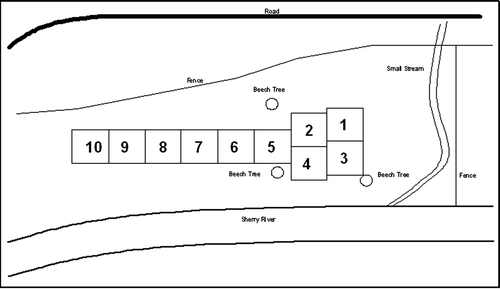
The herbicide application treatment was carried out by spraying every 2 months between October and April in 2006 and 2007 (i.e. on eight occasions) using glyphosate and a surfactant at 150 ml and 30 ml, respectively. Where woody weeds were considered a threat, clopyralid was added to the spray mix. Considerable care was taken to make sure that no native seedlings were exposed to herbicide. The carpet roll treatment was applied by laying out rolls of second-hand wool carpet with minimal dye colour. The carpet was laid pile down in lengths approximately 8 m long and 0.9 m wide, with slots cut in the carpet at 1-m intervals to accommodate the seedling stems. Pegs, rocks and small logs were used to weigh down the carpet margins, and the positioning of the carpet rolls was regularly checked to ensure movement of the rolls was not occurring. Rolls of commercial grade weed matting was purchased for the weed mat treatment; these were laid out and maintained as described for the carpet roll treatment. During trial establishment, the costs associated with each weed-control treatment were recorded. This information is presented in on a per-seedling basis.
Table 1 Estimated costs of different weed-control treatments per seedling over 2 years
Seedling measurements and analysis
Height and crown diameter were measured when the seedlings were planted and again in late July 2007; seedling mortality in 2007 was also recorded. Mortality was assessed by visual inspection. Crown area was calculated using the average of the crown diameter as measured along the north–south axis and the east–west axis. The effects of species and weed-control treatment on seedling mortality were assessed using logistic regression. Wald tests were used to assess the significance of differences in seedling survival rates between individual species and weed-control treatments. The increments in height and crown area for the surviving seedlings were assessed with analysis of variance to determine if species or weed-control treatments significantly influenced either measurement. Multiple comparison analysis (Tukey's Honest Significant Differences test) was used to determine the statistical groupings of species and weed-control treatments for height and crown area increment. All statistical analysis was performed with R (R Development Core Team Citation2010).
Results
Survival
The type of weed-control treatment significantly (P=0.04) affected the number of seedlings surviving in the plots after 2 years (). Survival rates were 69% with herbicide application, which was significantly higher than that with carpet roll and weed mats (both 53% survival) or with no additional weed control (49% survival). The variation in seedling survival with species was substantial (P<0.001). Only one A. serrata seedling (from forty planted) survived the 2-year period, whereas survival of C. australis seedlings was 85%; survival rates for the other species varied from 40% to 75% (). No significant interaction between weed-control treatment and species was observed in the analysis of seedling survival.
Height and crown area increments
Height increments over the measurement period varied significantly with weed-control treatment and across species ( and ). Seedlings planted into weed mats grew more than seedlings planted with either no additional weed-control treatment (P=0.006) or ongoing herbicide application (P=0.03). With regard to species, height increments were greater in P. tenuifolium seedlings than K. ericoides and P. totara (both P<0.001) and P. regius seedlings also added more height than P. totara (P=0.005).
Figure 4 Effects of weed-control treatment on height increments of surviving seedlings from 2005 to 2007 (means with error bars indicating SEM; n=34 for control, 48 for herbicide and 37 for carpet and weed mat). Letters indicate statistically significant differences in mean height increment between treatments at α = 0.05.
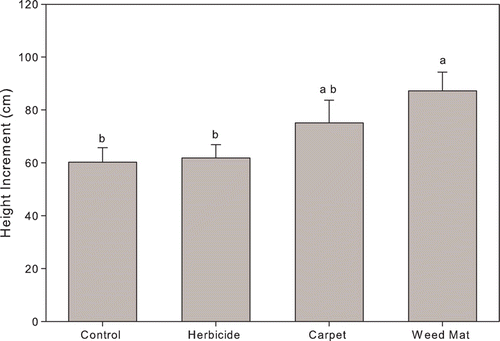
Figure 5 Differences between species in height increments of surviving seedlings from 2005 to 2007 (means with error bars indicating SEM; n=1 for Aristotelia serrata, 34 for Cordyline australis, 16 for Coprosma robusta, 22 for Kunzea ericoides, 25 for Plagianthus regius, 28 for Pittosporum tenuifolium and 30 for Podocarpus totara). Letters indicate statistically significant differences in mean height increment between species at α = 0.05. No error bar or letter is presented for A. serrata as only one specimen survived.
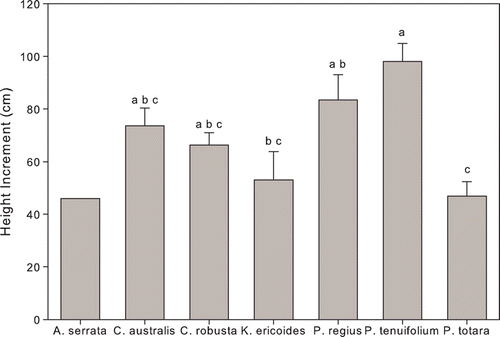
Crown area increments also varied significantly with weed-control treatment and plant species (both P<0.001). Seedlings planted into weed mats developed more crown area than seedlings with no additional weed-control treatments or ongoing herbicide treatment (both P<0.001), while crown area development was also greater with carpet rolls than no additional weed control (P=0.004) (). Cordyline australis seedlings developed more crown area over the measurement period than any other species in the trial (), and significant difference were also observed between P. regius and K. ericoides (P=0.03), P. regius and P. totara (P=0.008) as well as P. tenuifolium and P. totara (P=0.02).
Figure 6 Effects of weed-control treatment on crown area increments of surviving seedlings from 2005 to 2007 (Means with error bars indicating SEM; n as for ). Letters indicate statistically significant differences in mean crown area increment between treatments at α = 0.05.
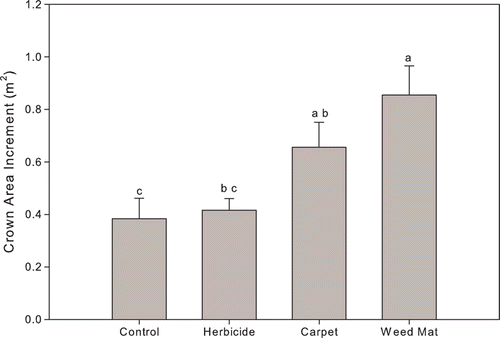
Figure 7 Differences between species in crown area increments of surviving seedlings from 2005 to 2007 (Means with error bars indicating SEM; n as for ). Letters indicate statistically significant differences in mean crown area increment between species at α = 0.05. No error bar or letter is presented for Aristotelia serrata, as only one specimen survived.
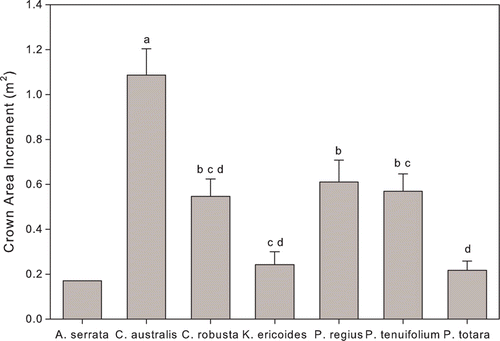
As only one A. serrata seedling survived, it was not possible to evaluate the variation in height and crown area increments for this species, so it was excluded in the analyses of variation with species. There were no significant interactions between weed-control treatment and species for either seedling height increment or crown area increment.
Discussion
The increased rate of seedling survival associated with the application of herbicide confirms that weed control can substantially enhance the establishment of native riparian zones, but the lack of any effect with the carpet roll and weed mat treatments clearly indicates that not all conventional weed-control methods will improve seedling survival at this site. These results are similar to those reported in previous studies (e.g. Sweeney et al. Citation2002; Sweeney & Czapka Citation2004; Gibson-Roy et al. Citation2010), which identified herbicide based treatments as the most successful weed-control strategy in terms of seedling survival. The substantial variation in seedling survival with plant species supports the importance of site appropriate species selections, which has also been demonstrated previously in other studies investigating the establishment of plants in riparian zones (e.g. McBride & Strahan Citation1984; Chambers & Linnerooth Citation2001; Sheley et al. Citation2006). In this case, the poor survival rate of A. serrata and, to a lesser extent, C. robusta, was most likely because of susceptibility to frost damage (McGlone et al. Citation2004).
In terms of height and crown area, the greatest gains were associated with the weed mat treatment, while the herbicide treatment produced no benefit when compared with the control. This is in opposition to several other studies into the effects of variation in weed-control techniques (e.g. Sweeney et al. Citation2002; Sweeney & Czapka Citation2004; Geyer et al. Citation2006), which identified herbicide treatments as more advantageous for plant growth, or at least no worse, than weed mats or similar physical barriers. The positive effect on growth associated with weed mats and, to a lesser extent, carpet rolls, may be the results of modification to the soil environment, as these materials also insulate the soil environment, potentially diminishing temperature fluctuations and increasing moisture availability (Smaill et al. Citation2008). Alternately, the lack of substantial increases in growth rates with herbicide application may be the result of spray drift, but given the increased rates of seedling survival with herbicide application this is considered unlikely. The substantial variation in growth with species over the measured period was again likely a product of the differences in the suitability of the different species for the site conditions, as has been observed previously in various studies (e.g. McBride & Strahan Citation1984; Chambers & Linnerooth Citation2001; Sheley et al. Citation2006), as well as the inherent differences in the growth behaviour of the different species.
These results complicate identification of the optimum weed-control treatment, although this issue can been resolved by considering the desired objective of planting efforts. Although seedling survival was greater with the herbicide treatment than the weed mat treatment, the total increase in crown area with herbicide over the 2-year period was actually less than that achieved by plants growing with the weed mat treatment (19.9 m2 and 31.6 m2, respectively); the total increase in crown area with carpet rolls was also greater (24.2 m2). The greater growth rates associated with the weed mat and carpet roll treatments suggest that these weed-control strategies will provide a more effective method to successfully re-establish the Sherry River riparian zone by allowing a greater volume of native biomass to develop within the same period, even if this biomass is comprised of fewer individual plants. The additional height and diameter growth obtained from these treatments should also promote suppression of weeds in future years, thereby decreasing the need for further weed-control programmes.
With regard to the cost and practical considerations associated with the weed-control treatments, although it was calculated that herbicides provided the cheapest means of weed control, herbicides require regular applications that need to be carried out by an experienced operator as spray-drift can be very damaging to native seedlings. In comparison, there are no chemical risks associated with weed mat and carpet, and for the 2-year duration of the trial, they were ‘one-off’ treatments that did not need to be repeated. However, it should also be noted that the installation of weed mat or carpet is laborious and only practical on flat, smooth surfaces. In addition, if not properly prepared (slots cut for seedlings) and held in place by weights or pegs, they can move over young trees, or lift and allow weeds to establish. Over time, weed growth can be prolific around edges and in the central slit. If these weeds are allowed to reach maturity and release seed, the local seed bank in the soil will be renewed, whereas with herbicides, fewer weeds can reach maturity and hence the local soil seed bank is depleted. Despite these issues, it appears that weed mats provide the best strategy for controlling weeds and promoting the growth of native seedlings at the Sherry River trial site. However, it must be noted that this is not a blanket recommendation, as the site-specific factors mentioned above should also be considered when determining the optimum establishment strategy.
In terms of species, C. australis had the best survival rate, developed the most crown area and performed strongly in terms of height increments. This does not agree with previous research indicating C. australis was not optimal for riparian planting (Czernin & Phillips Citation2005), although weed control was not a component of the earlier study. It could therefore be considered the best candidate for planting at this site with weed control, although the fine-edged crown margins of this species, together with shorter crowns that do not expand as rapidly with maturity as other species (such as P. tenuifolium and C. robusta), decrease its ability to shade out competing vegetation over the longer term. Location and climate based genotypic variability has been observed in the growth rates of C. australis (Harris et al. Citation2003), and this may need to be considered when sourcing C. australis seedlings for different sites.
The growth increments associated with P. tenuifolium and P. regius suggest that these species be used in preference to P. totara. Although survival rates for P. totara were greater, the mean growth increments and absolute increases in volume for P. tenuifolium and P. regius across the trial were substantially greater, making them better candidates for planting at locations similar to the trial site. A previous riparian trial examining the growth of C. australis, P. tenuifolium and P. regius along with several other native species also found these species generally performed well in terms of root depth and spread, further supporting the use of these three species (Marden et al. Citation2005). The growth rates P. totara were much less than those obtained in other studies of seedling development in this species (e.g. Bergin Citation2003), suggesting the Sherry River riparian environment was unsuitable despite the high survival rate of this species. As there were no significant interactions between species and weed-control treatment, there is no reason to attempt to match any species with a particular weed-control treatment, simplifying recommendations for planting strategies.
As a final comment, much effort was made to involve the local community in native plant establishment alongside the Sherry River. Visits to the trial site and community planting days were useful in transferring results and establishment techniques to local people. Complementing such days was the production of an easy-to-read and practical ‘best-bet’ guideline manual covering all the steps for successful native plant establishment (Ledgard & Henley Citation2009). Although these guidelines have been produced for the Sherry River environment, they are likely to have application elsewhere.
Acknowledgements
The authors are most grateful to Sherry River farmers, Paul and Nicky Bavin, for the use of their land for the trial and for their assistance with animal control. We also acknowledge the funding received from the Foundation of Research Science and Technology under the Integrated Catchment Management Programme (CO9X0305), led by Andrew Fenemor and Chris Phillips of Landcare Research, as well as the Transpower Landcare Trust grant, which paid for nursery seedlings. We thank Murray Davis for valuable assistance in the preparation of the manuscript and the suggestions of the reviewers and editorial staff. Finally, Barbara Stuart, the Nelson/Marlborough regional co-ordinator for the New Zealand Landcare Trust, has continually acted as an enthusiastic facilitator in terms of public relations and arranging planting stock and fencing.
References
- Bergin , DO . 2003 . Early performance of planted totara in comparison with other indigenous conifers . New Zealand Journal of Forestry Science , 33 : 205 – 224 .
- Bergin D , Gea L 2007 . Native trees—planting and early establishment for wood production . New Zealand Indigenous Tree Bulletin No. 3 (revised edition) Rotorua New Zealand Forest Research Institute Ltd .
- Chambers , JC and Linnerooth , AR . 2001 . Restoring riparian meadows currently dominated by Artemisia using alternative state concepts—the establishment component . Applied Vegetation Science , 4 : 157 – 166 .
- Crozier ER 1991 . Practical animal repellents for tree seedlings: a success story . In : Menzies MI , Parrott GE , Whitehouse LJ . Efficiency of stand establishment operations . Proceedings of the IUFRO Symposium, Rotorua, September 1989. Ministry of Forestry, FRI Bulletin 156 . Pp. 172 – 177 .
- Czernin , A and Phillips , C . 2005 . Below-ground morphology of Cordyline australis (New Zealand cabbage tree) and its suitability for river bank stabilisation . New Zealand Journal of Botany , 43 : 851 – 864 .
- Davies-Colley , RJ , Nagels , JW , Smith , RA , Young , RG and Phillip , CJ . 2004 . Water quality impact of a dairy herd crossing a stream . New Zealand Journal of Marine and Fresh Water Research , 38 : 569 – 576 .
- Davis M , Douglas G , Ledgard N , Palmer D , Dhakal B , Thomas P , Bergin D , Hock B , Barton I 2009 . Establishing indigenous forest on erosion-prone grassland: land areas, establishment methods, costs and carbon benefits . Contract report for MAF, Wellington (MAF POL 0809-11192) .
- Dodd MB , Ritchie H . 2007 . Farming with native trees: a guide for farmers from Northland to Waikato . New Zealand Indigenous Tree Bulletin No 5. Rotorua, New Zealand Forest Research Limited .
- Environment Canterbury 2006 . A guide to managing waterways on Canterbury farms . Christchurch, Environment Canterbury .
- Environment Southland 2008 . Land beside water Fact Sheet series: native plants . Invercargill, Environment Southland .
- Environment Waikato 2004 . Clean streams: A guide to managing waterways on Waikato farms . Hamilton, Environment Waikato .
- Fonterra Co-operative Group 2003 . Dairying and clean streams accord . Auckland, Fonterra Co-operative Group .
- Geyer , WA , Atchison , RL and Carlisle , J . 2006 . Evaluation of synthetic mulches on the establishment and growth of cottonwood . Journal of Sustainable Agriculture , 28 : 145 – 156 .
- Gibson-Roy , P , Moore , G and Delpratt , J . 2010 . Testing methods for reducing weed loads in preparation for reconstructing species-rich native grassland by direct seeding . Ecological Management and Restoration , 11 : 135 – 139 .
- Harris , W , Beever , RE , Parkes , S , Webster , R and Scheele , S . 2003 . Genotypic variation of height growth and trunk diameter of Cordyline australis (Lomandraceae) grown at three locations in New Zealand . New Zealand Journal of Botany , 41 : 637 – 653 .
- Hewitt AE 1992 . New Zealand Soil Classification . Lower Hutt, DSIR Land Resources .
- Langer ER , Rodgers , BE 2004 . Riparian vegetation: classification and rehabilitation opportunities in a weedy environment, Sherry River . New Zealand Limnological Society, Restoration of Degraded Systems to Achieve Sustainability, Waiheke Island, 29 November–3 December .
- Ledgard NJ , Dungey HS 2010 . A survey of New Zealand experience in propagation and establishment of native forest species . In : Barton I , Gadgil R , Bergin D . Proceedings of the Tane's Tree Trust 10th Anniversary Conference and Workshop, University of Waikato, 18–20 November 2009 . Pp. 58 – 63 .
- Ledgard NJ , Henley DG 2009 . Native plant establishment in the Sherry River, Motueka catchment—‘best-bet’ guidelines . Christchurch, Scion .
- Marden , M , Rowan , D and Phillips , C . 2005 . Stabilising characteristics of New Zealand indigenous riparian colonising plants . Plant and Soil , 278 : 95 – 105 .
- McBride , JR and Strahan , J . 1984 . Establishment and survival of woody riparian species on gravel bars of an intermittent stream . American Midland Naturalist , 112 : 235 – 245 .
- McGlone , MS , Dungan , RJ , Hall , GMJ and Allen , RB . 2004 . Winter leaf loss in the New Zealand woody flora . New Zealand Journal of Botany , 42 : 1 – 19 .
- Ministry for the Environment 2001 . Managing waterways on farms: a guide to sustainable water and riparian management in rural New Zealand Wellington Ministry for the Environment
- Nagels , JW , Davies-Colley , RJ , Donnison , AM and Muirhead , RW . 2001 . Faecal contamination over flood events in a pastoral agricultural stream in New Zealand . Water Science and Technology , 45 : 45 – 52 .
- NIWA 2011 . CliFlo: NIWA's National Climate Database on the Web . Wellington, National Institute of Water and Atmospheric Research. Retrieved 12 April 2011, from http://cliflo.niwa.co.nz .
- Phillips CJ 2005 . Erosion and sediment control using New Zealand native plants—what do we know? In: Proceedings of Erosion Control Seminar, Protecting the environment as an asset. NZ Institute of Highway Technology, Palmerston North, 11–13 September .
- Phillips CJ , Marden M 2003 . Where the rubber meets the road: the role of riparian management in ICM . Paper presented at ICM Australian Water Association Catchment Management Conference, Sydney, 26–27 November .
- Pollock KM 1986 . Plant Materials Handbook for Soil Conservation . Volume 3, Native Plants. Water and Soil Miscellaneous Publication, No 95. Wellington, National Water and Soil Conservation Authority .
- Porteous T 1993 . Native forest restoration . A practical guide for landowners. Wellington, Queen Elizabeth the Second National Trust .
- R Development Core Team 2010 . R: A language and environment for statistical computing . Vienna, R Foundation for Statistical Computing .
- Sheley , RL , Hook , PB and LeCain , RR . 2006 . Establishment of native and invasive plants along a rangeland riparian gradient . Ecological Restoration , 24 : 173 – 181 .
- Smaill , SJ , Clinton , PW and Greenfield , LG . 2008 . Postharvest organic matter removal effects on FH layer and mineral soil characteristics in four New Zealand Pinus radiata plantations . Forest Ecology and Management , 256 : 558 – 563 .
- Sweeney , BW and Czapka , SJ . 2004 . Riparian forest restoration: why each site needs an ecological prescription . Forest Ecology and Management , 192 : 361 – 373 .
- Sweeney , BW , Czapka , SJ and Yerkes , T . 2002 . Riparian forest restoration: increasing success by reducing plant competition and herbivory . Restoration Ecology , 10 : 392 – 400 .
- Taranaki Regional Council 1993 . Management of riparian margins in Taranaki . Implementation strategy. Taranaki, Taranaki Regional Council .
- Van Krayenoord CWS , Hathaway RL 1986 . Plant materials handbook for soil conservation. Volume 2, Introduced Plants , Water and Soil Miscellaneous Publication, No 94 Wellington National Water and Soil Conservation Authority .
